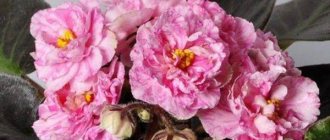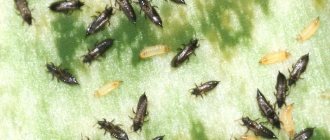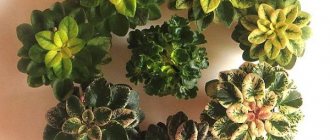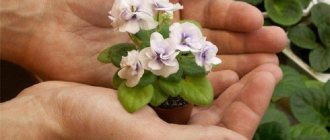The beautiful inspires the beautiful. Breeders often new varieties are named after songs, paintings, and dances. So the passionate and enchanting dance - Tango - immediately turned into four indoor violets.
These varieties were bred by three different breeders, and despite some similarities among some of them, they are all very different.
Each of them has its own characteristics , both externally and in care technology, and only by following the rules can you grow the most healthy and abundantly flowering plant.
In the article you will learn in more detail everything about violets AV-Tango (Fialkovod), RS-Tango (S. Repkina), NK-Tango on coals (N. Kozak).
Violet AV-Tango (Violet grower)
Luxurious violet AB-Tango.
Like most modern indoor violets, AB-Tango belongs to the genus of hybrid Saintpaulias from the Gesneriev class. The variety was bred by a breeder who calls himself Violetgrower , this is indicated by the letters AB in front of the name. The unusual photo and description of the AB-Tango violet will not leave flower growers indifferent.
The rosette is of a standard size, regular shape, very smooth and neat. The leaves are on short stalks, their shape is slightly oval. The plate is quite large, which makes the rosette a little large, but due to the length of the cuttings, it is not loose.
The flowers are very large, double stars . The color is very rich, dark cherry, with an amazing, deep shade. It usually blooms profusely, with a large head. The peduncles are small and therefore the flowers do not fall onto the leaves, but form a beautiful bouquet.
Violet sport AV-Tango.
There are cases when a young plant blooms with white spots on the petals. This could be a sport of the AB-Tango variety, or simply an unsuccessful first flowering, but you can tell for sure only after waiting for the second.
Features of flowering, growth and reproduction
It grows quickly, but is in no hurry to bloom. Usually it blooms already in a permanent pot, at the age of 12-13 months, sometimes earlier, but less often.
It blooms in a large bouquet-cap, with flowers reaching a size of 7 cm, but the more there are on the peduncle, the smaller they are. The peduncles are thin but short, and this prevents the flowers from falling off, despite their size.
Flowers can change color depending on the conditions :
- In the heat and with plenty of light, they become darker, almost velvety;
- In a cool place and lack of light, they become very light. The buds last quite a long time.
The variety is propagated in different ways:
- Leaf cuttings - children repeat their mother’s characteristics as often as possible;
- Stepchildren – repetition of features almost 100%;
- Peduncles - often used to secure unusual flowering;
- Seeds - for obtaining new varieties, this method is ideal.
Attention! A feature of the variety is its behavior when propagated by leaf cuttings. After planting, the leaf first produces a peduncle, and only after that the children appear. (happens often, but not always).
Reviews about violet
Review 1 A very undemanding variety, it grows literally everywhere (I have three of them), on a shelf, on a windowsill, and just in the center of the room on a table. The flowers are invariably large, and there are always many of them.
They reproduce well, but I give away or sell most of the babies. And those that remain with me grow quickly and bloom too.
The variety grows and reproduces well.
Review 2 I bought two leaves and was shocked. Of the 5 children I got from them, 2 turned out to be sports. This pleased me to some extent, because I received two different Saintpaulias at once.
The babies grew quickly and bloomed too. The first flowers are not very large, but subsequent blooms have caught up in size with the original. Subsequent reproduction did not produce as many sports, but it is almost impossible to get AB-Tango from sports; out of many of my children, only one.
Description and features of the variety LE-Polina Viardot
LE-Polina Viardot is the creation of Vinnitsa breeder Elena Lebetskaya, who over the years of her painstaking work has developed many worthy varieties. The violet was first introduced in 2012.
Pauline Viardot is a standard-sized Saintpaulia, but the rosette grows small and symmetrical. The leaves tend to droop down over the edges of the pot, so the violet becomes even more compact. At a young age, it can stretch out long petioles, due to which it looks loose. In adult plants, this deficiency disappears; the leaf plates are arranged in continuous rows, overlapping each other. LE-Pauline Viardot attracts attention with the beauty of its white-green variegated leaves, which take on the shape of spoons.
LE-Pauline Viardot's flowers are large, reaching 8 centimeters. They belong to the “star” type and can be simple, semi-double, and in some cases – completely double. The wine-red hue is complemented by a thin wavy white border, due to which the buds look very elegant and festive at any stage of dissolution.
In the first flowering, even fully opened buds can be small in size, but in subsequent times the violet makes up for lost time, showing its full potential. Despite the abundance of peduncles, it is difficult to achieve cap flowering from Polina Viardot - this is due to the small number of buds on each of them (1-2, occasionally 3 pieces). However, even despite the lack of a bouquet of several large flowers, it is quite enough for a compact rosette.
LE-Pauline Viardot blooms infrequently, on average once a year. Beet-colored flower stalks give the violet a special charm and look very harmonious together with the buds. Due to the large size and heavy weight of the flowers, they may lean slightly down towards the leaves. It is worth noting that an adult plant of this variety will not produce buds until it has grown a full-fledged rosette. That is why it is necessary to provide the violet with sufficient lighting, watering and fertilizing.
When propagated by leaf cuttings, LE-Polina Viardot produces an average of 2 babies that grow very slowly.
Violet RS-Winter Tango (S. Repkina)
Delicate violet RS-Winter Tango.
Like the previous variety, RS-Winter Tango belongs to the genus of hybrid Saintpaulias from the Gesneriev class. The letters RS before the name indicate that this variety was developed by breeder S. Repkina .
Saintpaulia rosette:
- Standard;
- With light green leaves;
- Round shape;
- And a wavy edge.
The cuttings are quite long , and this makes the rosette a little loose.
Violet flowers:
- Large;
- Terry;
- With corrugated edge of petals.
The color is quite interesting and sometimes not completely clear. From the edge to the center the color changes gradually , from white to pale pink, with a transition through cream.
No sports were recorded in this variety, but this does not exclude the possibility of their occurrence.
Features of flowering, growth and reproduction
The rosette develops well, usually does not pull leaves up even on the windowsill . It rarely blooms in adolescence, usually ripens by 11-12 months. The first flowers are a little smaller, but there are usually quite a lot of them.
The flowering is cap, despite the slightly elongated peduncles, the buds are kept in the center and form a beautiful bouquet. The buds last quite a long time, and the mail does not react to changes in temperature.
In a cool room it can produce completely white flowers, without a pink tint, but in the heat, on the contrary, almost the entire petal is cloudy, but these changes are almost imperceptible.
The variety responds well to all methods of propagation, so each gardener can choose the appropriate option for himself :
- Leaf cuttings;
- Stepsons;
- Peduncles;
- Seeds (for breeding new varieties).
Reviews about violet
Review 1 One of my favorite varieties. The shape of the flowers is simply irresistible, and the color is reminiscent of apple blossoms, white petals with a slight pink tint.
I've wanted this violet for a long time, but I couldn't find it. I bought a leaf at the exhibition, I have never grown any variety so carefully, and after the first flowering I simply melted.
The snow-white flowers of this variety are liked by many gardeners.
Review 2 For several years I had Saintpaulia RS-Winter Tango, but unfortunately, it got sick and disappeared. I couldn’t even save even one leaf suitable for propagation; I simply noticed the disease at the wrong time. Now I'm looking for where to get it.
Before the illness, she bloomed beautifully, and I couldn’t get enough of her. The flowers are beautiful, very delicate and large.
Violet RS-Tango (S. Repkina)
Fairytale violet RS-Tango.
The variety RS-Tango is a registered sport from the variety RS-Duchess. The RS designations make it clear that both varieties were developed by breeder S. Repkina. Both belong to the genus of hybrid Saintpaulias from the Gesneriev family. A photo of the RS-Tango violet is presented above.
The rosette is of a standard size, the leaves on long stalks are not very large, rounded with small teeth along the edge, and wavy. Light green color complements dark flowers. The leaves tend to lift the sheets upward.
The flowers are large, up to 7 cm, double, with a corrugated edge of the petals. The color is very deep , purple, as if velvet on the front, the back is only a little purple, and along the edge there is a light green, pencil border.
The variety has an unusual flower color.
Important! Considering the origin of the variety, a phenomenon often occurs when, during propagation, it moves towards the mother variety - PC-Duchess.
Features of flowering, growth and reproduction
The flower grows moderately; an adult plant can be obtained 11-12 months after planting the cuttings. It blooms at 10-11, sometimes even a little earlier. The first flowering is not impressive, the flowers are not very large and there are not many of them.
flower stalks :
- Middle length;
- Moderate thickness;
- And they stay in the center of the socket.
Usually it blooms gradually, raising more and more new buds , while there is no amicable flowering that could form a cap. The buds do not last very long, but replace each other very smoothly.
The color of flowers varies greatly depending on the temperature:
- In a cool room, the color becomes much lighter and the velvety is lost, but the light green fringe along the edge of the petals becomes more expressive;
- If the temperature is higher, the color becomes richer, more velvety, but the fringe is a little lost and may even be absent.
This variety can be propagated in any way that is convenient for the grower :
- Leaf cuttings;
- Stepchildren;
- Peduncles;
- Seeds (for breeding a new variety).
Reviews about violet
Review 1 I bought a blooming RS-Tango, took it and just disappeared. I managed to take a couple of leaves for propagation, and they all took root and produced 1-2 babies. They grew quickly and just as well, and most importantly they bloomed together.
The first bloom was not as colorful and abundant as the large rosette I bought, but the flowers showed their beauty. Each subsequent flowering was only better, during the second I gave away almost all the babies. But the leaves take root easily, so I’ll soon restore the quantity.
Violets have many positive reviews from flower growers.
Review 2 I took a piece of paper from a friend, and it immediately made me happy with three children. After I planted them, one disappeared, but the other two began to grow rapidly. I waited until closer to a year for the first flowering, and it was not what I expected. The flowers are small and almost not double.
I decided to give them a chance and waited a second time, and most importantly not in vain. The flowers became correct in both size and shape. Now every time they are pleasing to the eye.
Violet NK-Tango on coals (N. Kozak)
Bright Saintpaulia NK-Tango on coals.
The variety was bred by breeder N. Kozak , as evidenced by the letters NK in front of the name. Tango on Coals belongs to the genus of standard-sized hybrid Saintpaulias, from the Gesneriev class.
The rosette is slightly spreading, the leaves are slightly oblong with a pointed tip. The color of the sheets resembles bottle glass, but is a little darker in shade; a thin, edged variegation of a pink hue is visible along the edge, and the reverse is red.
The flowers are very large, double and semi-double with a wavy edge of the petals. The color is quite dark , burgundy, and there is a white pencil border along the edge. It blooms profusely, above the rosette, usually a bouquet of flowers rises, but it can hardly be called a hat, because of the weight the flowers fall on the leaves.
Features of flowering, growth and reproduction
The bush develops quickly, especially the leaves. The cuttings of the leaves grow throughout their life , so they become very long, and this makes the rosette a little spreading.
It blooms while still a teenager, but the first flower stalks usually bear only 1-2 buds, and they are not very large.
An adult rosette, in most cases produces a beautiful bouquet. The peduncles are tall and not very thick ; each can have up to 5 heavy buds, which leads to their lowering onto the leaves.
The flowers bloom gradually and fade away as well, on average each one lasts a week. The flowers are almost not affected by temperature, except that the border may be absent in the heat.
Attention! The cap of their flowers is extremely rare, and for this all the peduncles must stretch upward, and this, taking into account the weight of the flowers, their number on each peduncle, as well as its thickness, is almost impossible.
The variety reproduces easily, produces many children and takes root well. The method of leaf cuttings or stepsons is suitable for this, thus accurately conveying the variegation of the leaves. Sometimes peduncles are rooted to consolidate unusual flowering, but then there is a risk of losing spots on the leaves.
Reviews about violet
The variety reproduces and grows well.
Review 1 The flowers are crazy, they are so huge and cool. The only drawback is that the weight of the flower stalks falls on the leaves.
It reproduces well for me, consistently produces one baby from each rooted leaf, but I haven’t had any stepchildren yet.
Review 2 I bought a leaf, I was very afraid that it wouldn’t take root, but in the end I got two babies at once. They grew quite quickly and bloomed surprisingly early. The first flowers were smaller, and already from the second flowering the size exceeded expectations.
I was hoping to get a bunch of flowers at least once, but then I realized that the flowers just lay on the leaves, they were too heavy.
Breeding history
The variety was bred by breeder Svetlana Repkina from Lugansk (Ukraine) in 2008. Svetlana is a member of the Viola club, which is part of the American association AVSA. The breeder has her own online store where you can purchase cuttings of the varieties she bred.
Svetlana herself gives the following description of “Duchess”: a bouquet of huge, double and semi-double ruffled white flowers with plum “prints” is very elegant against the backdrop of medium green quilted foliage.
The plant amazes with the royal size of the rosettes, inflorescences, and the splendor of flowering
In one of her interviews, S. Repkina admitted that in breeding work she always chased the size of the flower. I wanted to achieve large, beautiful ones, but I didn’t pay so much attention to the rosette, although many gardeners value Saintpaulias not only for their charming bouquet, but also for their compactness. So “Duchess” amazes with its size and volume of flowers, but its rosette is also large, it is also called “horse”: the leaves on long petioles can even hang outside the flowerpots.
Violet Cajun's Two to Tango
Unusual violet Cajun's Two to Tango.
The variety is standard size, belongs to the genus of hybrid Saintpaulias , the Gesneriev family. Cajun's Two to Tango was developed by breeder Belinda Thibodeaux in 2015.
The rosette is uniform, well formed, but the leaves love to hug the pot . The shape of the leaf plate is oblong with a pointed tip, and a slightly quilted fabric. The color of the leaves is dark green, which sets off especially well the white variegation along the edge. The amount of light on the leaves is small, but the older the leaf, the less it becomes.
The flowers are small, simple and semi-double pansies , the color is very blurry and is shades of lilac-lavender. The lower petals are lighter, sometimes almost white, while the upper petals are darker. Along the edge of the petals there is an uneven purple border.
Features of flowering, growth and reproduction
At home, the variety feels good, given the tendency of the sheets downward , it can, and even should, be placed on a windowsill or the edge of a shelf (away from lamps).
It grows confidently, although it is not in a hurry to bloom. The first flowering is less abundant than subsequent ones and occurs closer to 12-13 months of life.
The peduncles are straight and tend to the center of the rosette, resulting in the formation of a large head of flowers .
There are many buds, and there can be up to 7-8 of them on one peduncle; their size does not cause the peduncles to droop. The flowering period is long, each bud lasts a week, and they bloom very smoothly, one after another.
It is better to propagate by leaf cuttings and stepsons ; these methods guarantee the preservation of the pattern on the leaf plates. Peduncles can also achieve the desired result, but there is a risk of loss of variegation in children.
Reviews about violet
Review 1 Very delicate variety. It blooms for me for a very long time, I just can’t get enough of it. A delicate, small bouquet is simply mesmerizing.
I placed it on the coffee table in the room and, in addition to the beautiful flowers, I also admire the incomparable leaves.
It propagates easily, leaf cuttings produce one or two children, sometimes three, and produces few stepchildren, and this is good in its own way, the shape of the rosette does not deteriorate.
Review 2 I bought a baby Cajun's Two to Tango, I didn't want it to bloom for a long time, but I waited. The first flowers are very rare, but so delicate. The rosette is well formed.
Starting from the second flowering, the head of flowers is incomparable and simply outshines everything. Each new flowering confirms its simple and gentle superiority.
The most popular varieties of the AB series and their photos
Every collector has types that are the most popular. And the violet grower is no exception.
Polar bear
The flowers of this species are large and voluminous. They resemble balls in shape. The color of the petals is white, and the flowers themselves are densely double . The leaves are medium green, slightly wavy and quilted at the edges. Plant sizes are standard. It was released in 2015.
Bohemia
This indoor flower became available to Russian flower growers in 2015. The color of the flowers is similar to that of fragrant ripe cherries - it is burgundy-black. Dark green foxtails have sharp tips. This sorso blooms on all sides, the flowers form a dense ball resembling a hat.
We recommend watching a video about the violet variety “Bohemia”:
Kishmish
This variety of violet will allow you to grow large flowers, shaped like stars . The petals are dark crimson, their edges are white, corrugated. The rosette is compact and has medium green, toothed leaves that are slightly wavy. The variety was bred in 2015.
Coral Castle
The variety exhibits semi-double and double flowers. They look like pansies with a ruffled brown edge. Their color is coral-raspberry. The leaves are green, wavy and oval in shape. The bush sizes are standard.
Crimean Cherry
Pansies are distinguished by their corrugated petals . The flowers are double type and have a dark burgundy color. Leaves are dark green. They have an oval shape and a pointed tip. The leaves are slightly wavy. Standard sizes.
We recommend watching a video about the violet variety “Crimean Cherry”:
Terry Petunia
The flowers of this plant resemble roses with white petals, and along the edges there is a corrugated edging of dark cherry color. This is a small standard with a compact socket. It has medium green wavy leaves. The variety was released in 2015.
Caring for a plant at home
All of the varieties listed above have similar care requirements ; there are small deviations, but they are insignificant, and their failure to comply will not lead to fatal consequences.
Selecting a location
All Saintpaulias prefer places where there is a lot of light , but no direct sun. The room temperature can vary from 16 to 26° (depending on the season), but it is recommended to consistently maintain 22-24°.
It is important to take into account personal preferences of the variety:
- AV-Tango, RS-Winter Tango - grow well under lamps, but they are also comfortable on the windowsill, temperature 22-23°;
- RS-Tango - pulls leaves upward, therefore requires additional light, temperature 24-25°;
- NK-Tango on Coals and Cajun's Two to Tango are variegated, it is better to keep them in the shade to get more light spots on the leaves, temperature 20-22°.
Air humidity, under ideal conditions, is 60-70%. If there is a deficiency, this indicator can easily be replenished by adjusting the watering regime , but excess moisture can lead to diseases.
Watering, fertilizing
These varieties perform well on different types of watering :
- Classic – in a pallet or under sheets. Suitable for all five varieties. The frequency of the procedure depends on the drying of the soil, and in summer it is approximately once a week. In this version:
- Watering and fertilizing are carried out every other week;
- And the dosage of fertilizers is reduced by 2 times from the recommended and instructions.
- Wick – water is in the container and the plant takes it through the wick in the lower drainage hole. Not recommended for varieties RS-Tango and NK-Tango on Coals, as they are prone to elongation of leaf cuttings. Mineral fertilizers are added to the water constantly, in a dosage 7 times lower than usual.
Important! If possible, gardeners recommend choosing the classic watering method, since wick is not suitable for all varieties and not in all conditions.
Transplantation, pruning, rejuvenation
For full growth and health, flowers are regularly pruned, removing old, dying leaves and peduncles. also important to carry out transplants :
Violets should be replanted once a year.
- As it grows, the rosette with a lump of soil is transferred to a larger pot;
- Adult bushes are replanted once a year with a complete replacement of the soil and pruning of dying roots;
- During treatment, if necessary, the violet is replanted with a complete replacement of the soil, and sometimes the pot;
To rejuvenate, the rosette is cleaned from the lower rows of leaves and planted deeper, or the top is cut off, and then it is rooted as a young stepson or leaf cutting.
Reproduction
To obtain a baby that repeats the maternal characteristics, three methods are used :
- Leaf cuttings - material is taken from rows 2-3 and rooted in water, soil or moss;
- Stepchildren - planted with their own roots, or cut earlier and rooted like a leaf;
- Flower stalks - root fresh, not completely faded flower stalks and root them in the ground (this method does not guarantee the transfer of variegation of leaves to the baby).
Most often, Saintpaulias are propagated by leaves.
Saintpaulias are also , but this method is suitable for breeding a new variety, because even pollination of a flower with the same flower leads to a large percentage of children that do not repeat the mother rosette and its flowering.











